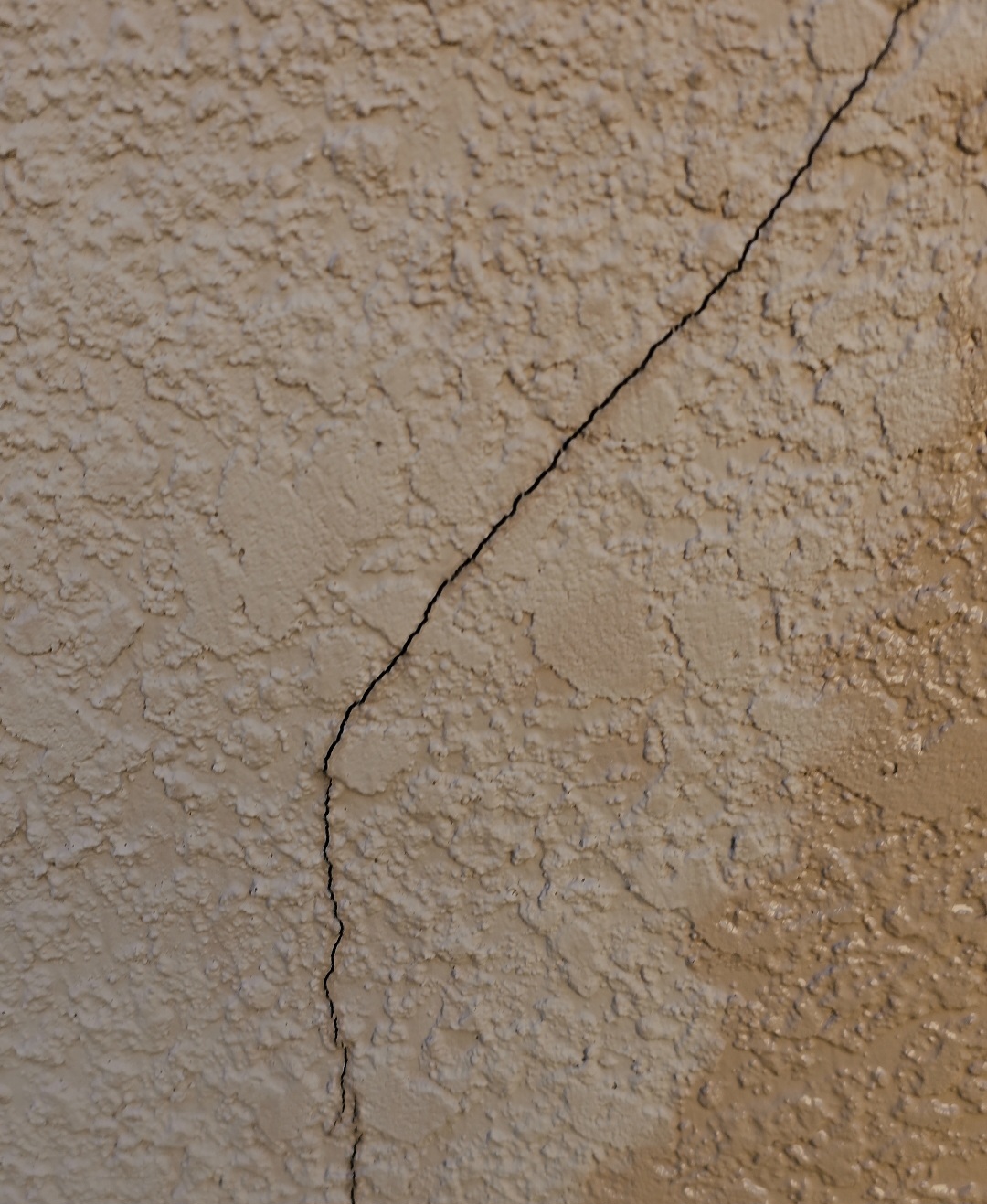
Why are cracks appearing in my house?
In Florida, there are three common types of stucco finish walls for homes: stucco on concrete block, Exterior Insulated Finishing System (EIFS), also known as synthetic stucco, and stucco on wood frame construction. Stucco over concrete block typically has fewer problems than the other two options, while EIFS is known for documented moisture intrusion issues and lawsuits dating back to the mid-1990s (for more information on EIFS, see What is the difference between EIFS and stucco?). This article will focus on the defects found in the third type of stucco: stucco applied over paper-backed metal lath on wood frame wall construction, which was particularly popular in Florida during the building boom of 2004 to 2008
Homeowners may become concerned when they notice buckling, ripples, and stains appearing in their stucco, as seen in the photo above. However, the issue usually begins with small cracks like those shown below, which are barely visible but allow water to penetrate the wall.
The inherent issue with using stucco on a wood-framed structure lies in the fact that wood is a material that is prone to move around due to fluctuations in humidity, which causes it to expand, contract, and sometimes warp. In contrast, stucco is a relatively rigid and stable material, but it tends to expand and contract with temperature changes more than wood. Thus, when stucco is applied to a wood wall, certain design features must be incorporated to prevent the stiffer stucco from cracking due to the differing movements of the less-flexible wood. The Florida Building Code specifies the use of ASTM C-926-06 standards for stucco application, which technically refers to it as «Portland Cement-Based Plaster.» These standards are based on five well-established benchmarks.
Stucco applied to a wood frame structure poses a challenge due to the natural movement of wood caused by humidity changes. As wood expands, shrinks, and twists, it can cause cracking in the comparatively stable and stiff stucco. To prevent this, built-in details must be incorporated into the stucco application to accommodate the differing movements of the materials.
The Florida Building Code specifies the application of stucco according to the ASTM C-926-06 specifications, which use the technically correct term «Portland Cement-Based Plaster.» These specifications are based on five well-established standards.
To resist cracking, stucco should be applied in three coats, with a minimum thickness of 7/8″ (excluding texture). Flexible control joints should be placed at regular intervals to absorb stucco expansion and contraction caused by temperature changes. A weep screed should be installed at the bottom of the wall to allow any water that penetrates the stucco to drain out behind it instead of being trapped and potentially causing damage to the wall framing. In cases where a wood-frame second floor is built on a concrete block first-floor structure, the weep screed will be located at the bottom of the second floor level.
Stucco poses a unique challenge when applied to a wood-framed structure due to the inherent movement of wood. The wood naturally expands, contracts, and twists with changes in humidity, while stucco remains relatively stable and stiff. To prevent the less-flexible stucco from cracking, special measures must be taken during installation.
One of these measures is the application of stucco in three coats, at least 7/8” thick (not including any texture) to resist cracking. Another measure is the installation of flexible control joints at regular intervals along the wall, which absorb the expansion and contraction of the stucco due to temperature changes.
A weep screed, located at the bottom of the wall, is also crucial in preventing water from penetrating the stucco and causing rot in the wall framing. Casing beads are used to wrap around any penetration points, such as windows, doors, and soffit returns, to prevent hairline cracks that could let water in.
Lastly, drips are necessary at any change of plane from a vertical to a horizontal under-surface of the stucco. This allows water to fall off at the corner and prevents it from migrating sideways due to surface tension.
Compared to the installation of regular siding, stucco installation is much more complex. Regular siding depends on simple down-lapping of smaller pieces of building material for waterproofing, and movement is absorbed by numerous overlapping joints plus caulk around doors and windows.
It’s important to note that ignoring any of these five anti-cracking measures can lead to stucco problems. While the issues may not be immediate, over time, small cracks can let in water that rusts the steel lath and opens the cracks further, allowing even more water in.
In some cases, casing beads are not installed at all, leaving the stucco vulnerable to cracking and water penetration around windows, doors, and soffit returns. Additionally, if the casing bead is not installed with a proper gap for flexible caulk, the caulk will not be able to prevent water intrusion. Furthermore, improper installation of the casing bead can lead to uneven spacing, which will make it difficult to install the window or door properly.
DRIPS: Without a drip edge at the change of plane between a vertical and horizontal
surface, water can migrate sideways due to surface tension, leading to water
infiltration. Drip edges that are not properly installed or are too small can
also lead to this problem. Additionally, if the drip edge is not installed at
all, water can accumulate at the corner and cause damage to the stucco over
time.
